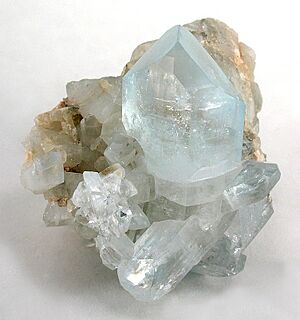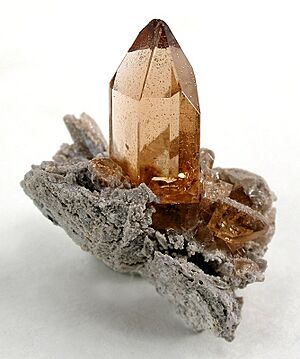Topaz facts for kids
Quick facts for kids Topaz |
|
|---|---|

Topaz crystal on white matrix
|
|
| General | |
| Category | Nesosilicate minerals |
| Formula (repeating unit) |
Al2SiO4(F,OH)2 |
| Strunz classification | 9.AF.35 |
| Crystal symmetry | Pbnm |
| Unit cell | a = 4.65 Å, b = 8.8 Å, c = 8.4 Å; Z = 4 |
| Identification | |
| Color | Colorless (if there are no impurities), white, blue, brown, orange, gray, yellow, yellowish brown, green, pink, reddish pink or even red |
| Crystal habit | Prismatic crystal |
| Crystal system | Orthorhombic |
| Twinning | Rarely on [111] |
| Cleavage | [001] Perfect |
| Fracture | Subconchoidal to uneven |
| Mohs scale hardness | 8 (defining mineral) |
| Luster | Vitreous |
| Streak | White |
| Diaphaneity | Transparent |
| Specific gravity | 3.49–3.57 |
| Optical properties | Biaxial (+) |
| Refractive index | nα = 1.606–1.629 nβ = 1.609–1.631 nγ = 1.616–1.638 |
| Birefringence | δ = 0.010 |
| Pleochroism | Weak in thick sections X = yellow; Y = yellow, violet, reddish; Z = violet, bluish, yellow, pink |
| Ultraviolet fluorescence | Short UV=golden yellow; Long UV=cream |
Topaz is a beautiful mineral often used as a gemstone in jewelry. It is made of aluminium, silicon, oxygen, fluorine, and hydroxide. In its natural state, topaz is usually colorless. However, tiny amounts of other elements can give it pale blue, golden brown, or yellow-orange colors.
Sometimes, topaz is treated with heat or radiation. This can change its color to deep blue, reddish-orange, pale green, pink, or even purple. While many people think of topaz as golden yellow or blue, it actually comes in many different colors, including clear. The rarest natural colors are pink, red, and soft golden oranges, sometimes with a hint of pink. Topaz is one of the hardest natural minerals found on Earth.
Contents
What is Topaz?
Topaz is a type of silicate mineral called a nesosilicate. It is known for being very hard. It also has a relatively low index of refraction, which affects how light bends when it passes through the stone. You can find topaz in many places around the world.
Where Did the Name "Topaz" Come From?
Most people believe the name "topaz" comes from the Greek words Topázios or Topázion. These words refer to St. John's Island in the Red Sea. This island was hard to find, and in ancient times, a yellow stone was mined there. This stone is now thought to be chrysolite, which is a yellowish olivine.
The name topaz was first used for the mineral we know today in 1737. Ancient Sri Lanka, also called Tamraparni, sent native oriental topazes to Greece and ancient Egypt. This led to names for the island like Topazius and Topapwene, meaning "land of the Topaz." The Roman writer Pliny said that Topazos was a legendary island in the Red Sea where the mineral "topaz" was first found. Another idea is that the word topaz might be linked to the Sanskrit word tapas, which means "heat" or "fire."
History of Topaz
In 1652, Nicols, who wrote one of the first books about minerals, wrote two chapters about topaz. In the Middle Ages, people used the name "topaz" for any yellow gemstone. But today, it only refers to the specific silicate mineral we call topaz.
Many English versions of the Bible, including the King James Version, mention topaz. However, these translations came from an older Greek translation that referred to a yellow stone that was likely chrysolite (which could be chrysoberyl or peridot), not true topaz.
People in England once believed that topaz could cure mental illness. The ancient Romans thought that wearing topaz would protect them from danger when they traveled. During the Middle Ages, people believed that if you wore topaz on your left arm, it would protect you from curses and the evil eye. They also thought that wearing topaz would make your body warmer, helping with colds or fevers. In Europe during the Middle Ages, people believed topaz could make their minds stronger.
Topaz as a Gemstone
Topaz is a popular gemstone. When it is cut and polished, it is used to make beautiful jewelry and other decorations. Orange topaz, also known as precious topaz, is the traditional birthstone for November. It symbolizes friendship and is the state gemstone of Utah. Blue topaz is the state gemstone of Texas.
What Does Topaz Look Like?
Naturally, topaz is colorless and sometimes has a grayish tint. It can also be golden brown to yellow. Because of this, it is sometimes confused with citrine, which is a less valuable gemstone. However, topaz is much heavier than citrine for the same size stone. This difference in weight can help tell them apart. Glass stones are also much lighter than topaz of the same size.
Different impurities and treatments can make topaz appear wine red, pale gray, reddish-orange, pale green, or pink (which is rare). It can be opaque, meaning you can't see through it, or transparent, meaning you can. The pink and red colors come from chromium replacing aluminum in the stone's structure.
Imperial topaz is a special type that is yellow, pink (if natural, it's rare), or pink-orange. Brazilian imperial topaz can be bright yellow to deep golden brown, and sometimes even violet. Many brown or pale topazes are treated to become bright yellow, gold, pink, or violet. Some imperial topaz stones can lose their color if left in sunlight for a long time.
Natural blue topaz is quite rare. Usually, colorless, gray, or pale yellow and blue topaz is heated and irradiated to create a more desired dark blue color. Mystic topaz is colorless topaz that has been given a special coating. This coating makes its surface show a rainbow effect.
Even though topaz is very hard, you need to be more careful with it than with some other hard minerals like corundum. This is because the atoms in topaz are not bonded as strongly in certain directions. This means topaz can break along a flat surface, called a cleavage plane, if it is hit hard enough.
Topaz has a relatively low index of refraction for a gemstone. This means that stones with large flat surfaces might not sparkle as much as stones cut from minerals with higher refractive indexes. However, good quality colorless topaz can still sparkle and look lively, more so than quartz cut in a similar way. When cut in a typical "brilliant" style, topaz might have a sparkling top surface surrounded by duller side surfaces, or sparkling side surfaces with a dull top. Topaz also takes a very fine polish, and you can sometimes tell it apart from citrine just by how slippery it feels. Quartz cannot be polished to this level of smoothness.
Another way to tell topaz from quartz is to place the unset stone in a special liquid like bromoform. Quartz will float in these liquids, but topaz will sink.
Where is Topaz Found?
Topaz is often found with silicic igneous rocks, which are types of rocks formed from cooled magma, like granite and rhyolite. It usually forms in granite pegmatites or in gas pockets within rhyolite lava flows. Examples include Topaz Mountain in Utah and Chivinar in South America.
You can find topaz with fluorite and cassiterite in many places around the world. These include the Ural and Ilmensky mountains in Russia, Afghanistan, Sri Lanka, the Czech Republic, Germany, Norway, Pakistan, Italy, Sweden, Japan, Brazil, Mexico, Flinders Island in Australia, Nigeria, and the United States.
Brazil is one of the biggest producers of topaz. Some clear topaz crystals from Brazil can be as big as boulders and weigh hundreds of pounds! The Topaz of Aurangzeb, seen by Jean Baptiste Tavernier, weighed 157.75 carats. The American Golden Topaz, a more recent gem, weighed 22,892.5 carats. Large, bright blue topaz pieces were found in the St. Anns mine in Zimbabwe in the late 1980s. Colorless and light-blue topaz can be found in very old granite in Mason County, Texas. There is no commercial mining of topaz in that area. It is also possible to create topaz in a lab.
Images for kids
-
Topaz Mountain, Utah, United States
See also
 In Spanish: Topacio para niños
In Spanish: Topacio para niños









